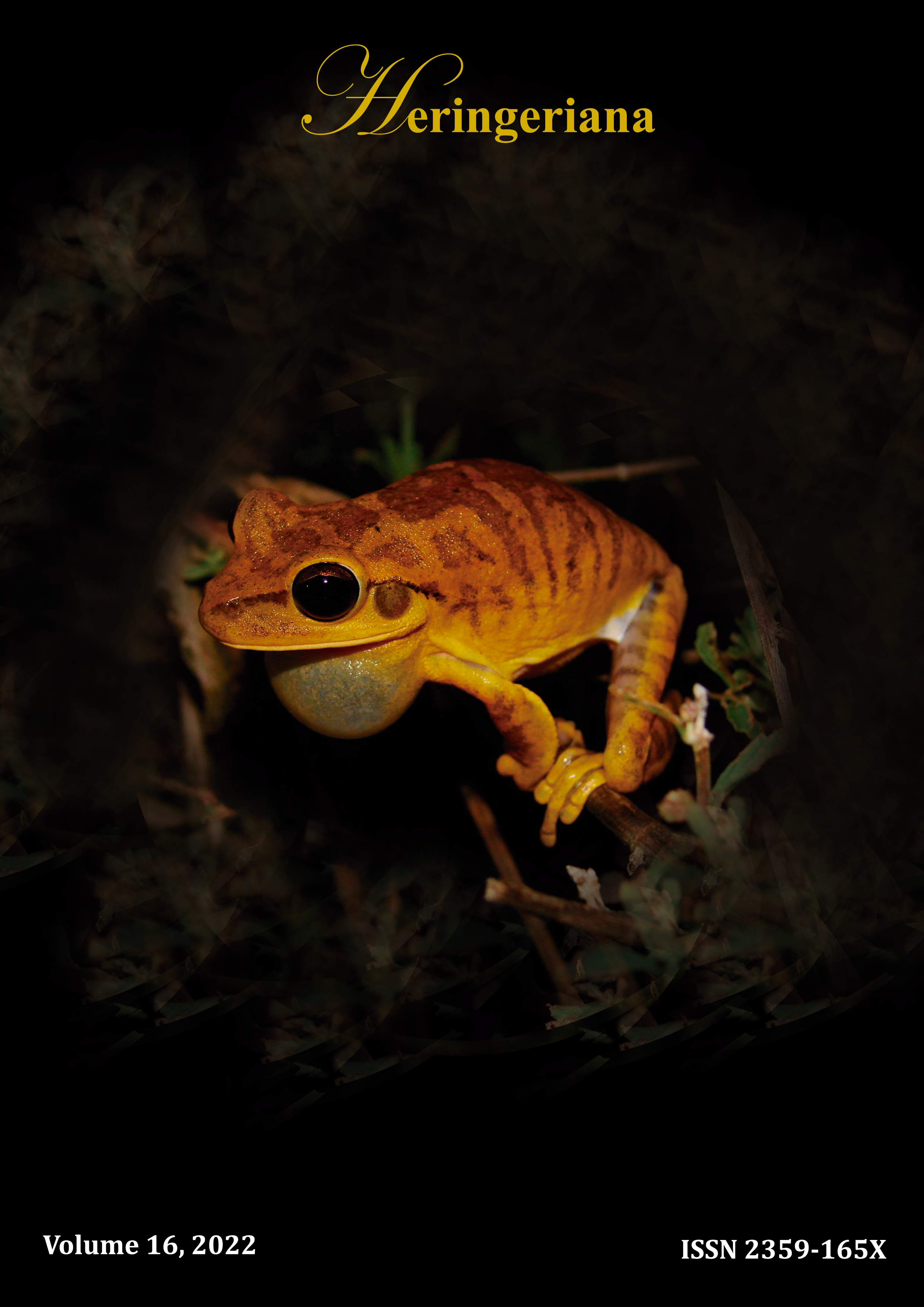Phycoflora associated to aquatic macrophytes in temporary lagoons in the semiarid region of Bahia, Brazil
DOI:
https://doi.org/10.17648/heringeriana.v16i1.918009Keywords:
ephemeral environments, cyanobacteria, microalgae, Northeast, periphytonAbstract
Brazilian semi-arid region includes territorial areas of eight states, from Northeast to Minas Gerais North, presenting two well-defined seasons during the year, a rainy season (December to April), and a dry one (May to November). During the short rainy season, temporary ponds are formed which are ecosystems that shelter a very peculiar macrophyte flora adapted to the high light incidence and seasonal rainfall in this region. Associated to this aquatic flora, there is a rich periphytic community, which includes, for example, bacteria, fungi, small metazoans, and especially a wide diversity of microalgae and cyanobacteria. In this context, the present work was carried out in order to characterize the periphytic phycoflora associated to aquatic macrophytes of temporary ponds in the Bahia semi-arid region. Sampling was performed in six temporary ponds located along the highway BA-052 (Estrada do Feijão), along July and September 2013. Seven macrophytes species and 43 periphytic taxa of microalgae and cyanobacteria were identified. This pioneering study contributes to filling the gaps in knowledge about the periphyton of temporary ponds, showing that, although they are ephemeral due to the rainfall seasonal pattern, they harbor an important diversity of macrophytes as well as a rich phycoflora. These primary producers are essential for the functioning of these temporary habitats, providing ecosystem services for human populations, as well as contributing to the biodiversity of semi-arid regions.
References
Aguilera, A., Berrendero Gómez, E., Kaštovský, J., Echenique, R.O. & Salerno, G.L. (2018). The polyphasic analysis of two native Raphidiopsis isolates supports the unification of the genera Raphidiopsis and Cylindrospermopsis (Nostocales, Cyanobacteria). Phycologia 57(2): 130-146.
Bicudo, C. D. M. & Menezes, M. (2006). Gêneros de algas de águas continentais do Brasil (chave para identificação e descrições). São Carlos. Rima. 473p.
Bicudo, C. E. M. & Menezes, M. (2010). Introdução: As algas do Brasil. In: FORZZA, R.C. et al. Catálogo de plantas e fungos do Brasil. Instituto de Pesquisa Jardim Botânico do Rio de Janeiro, Rio de Janeiro, pp. 49-60.
Bicudo, D. C., Tremarin, P. I., Almeida, P. D., Zorzal-Almeida, S., Wengrat, S., Faustino, S. B., Costa, L. F., Bartozek, E. C. R., Rocha, A. C. R., Bicudo, C. E. M. & Morales, E. A., (2016). Ecology and distribution of Aulacoseira species (Bacillariophyta) in tropical reservoirs from Brazil. Diatom Research, 31(3), 199-215.
Brandini, F.P., Silva, E.T., Pelizzari, F.M., Fonseca, A.L.O. & Fernandes, L.F. (2001). Production and biomass accumulation of periphytic diatoms growing on glass slides during a 1-year cycle in a subtropical estuarine environment (Bay of Paranaguá, southern Brazil). Mar. Biol. pp. 163-171.
Camargo, V.M., & Ferragut, C. (2014). Estrutura da comunidade de algas perifíticas em Eleocharis acutangula (Roxb.) Schult (Cyperaceae) em reservatório tropical raso, São Paulo, SP, Brasil. Hoehnea, 41(1), pp. 31-40.
Campelo, M.J.A., Silva, C.S. & Amorim, M.C.C. (2009) Comunidade fitoplanctônica em lagoas temporárias do semiárido pernambucano, Brasil. Centro Científico Conhecer - Enciclopédia Biosfera, Goiânia. 5(8), 11 pp..
Costa, I.A.S., Azevedo, S.M.F. O., Senna, P.A.C., Bernardo, R.R., Costa, S.M. & Chellappa, N.T. (2006) Occurrence of toxin-producing cyanobacteria blooms in a Brazilian semiarid reservoir. Brazilian Journal of Biology, 66(1B): pp. 211-219. DOI: http://dx.doi.org/10.1590/S1519-69842006000200005
Diniz, A. C. O., Diniz, L. P. & Melo Júnior, M. (2013) Registro fotográfico e variáveis abióticas de lagoas temporárias da caatinga de Pernambuco. In: XIII Jornada de ensino, Pesquisa e extensão – JEPEX 2013 – UFRPE: Serra Talhada, 09 a 13 de dezembro.
Esteves. F. A. (1998) Fundamentos em Limnologia. Ed. Interciência/FINEP. Rio de Janeiro, 226pp.
Furtado, O. M. F. D. M. (2018). Potencial para bioindicação e bioprospecção de microalgas e cianobactérias na Lagoa dos Índios, Macapá, Amapá. Programa de pós-graduação em ciências farmacêuticas, Universidade Federal do Amapá.
Graça, S., Garcia, M. J., & de Oliveira, P. E. (2007). Flora Diatomácea Moderna do Lago Estância das Águas Claras, Guarulhos (SP): Resultados Qualitativos. Revista Geociências-UNG-Ser, 6(1), 63-79.
Guiry, M. D. (2013). Taxonomy and nomenclature of the Conjugatophyceae (= Zygnematophyceae). Algae, 28(1), 1-29.
Guiry, M.D. & Guiry, G.M. (2022). AlgaeBase. World-wide electronic publication, National University of Ireland, Galway. https://www.algaebase.org; searched on 17 de fevereiro de 2022.
Houk, V. (2003). Atlas of freshwater centric diatoms with a brief key and descriptions. Part I. Melosiraceae, Orthoseiraceae, Paraliaceae and Aulacoseiraceae. Czech Phycology Supplement, Olomouc. 114 pp
Komárek, J., Kaštovský, J., Mareš, J., & Johansen, J. R. (2014). Taxonomic classification of cyanoprokaryotes (cyanobacterial genera) Taxonomic classification of cyanoprokaryotes (cyanobacterial genera) 2014, using a polyphasic approach. Preslia, 86, 295-33.
Kostygov, A. Y., Karnkowska, A., Votýpka, J., Tashyreva, D., Maciszewski, K., Yurchenko, V., & Lukeš, J. (2021). Euglenozoa: taxonomy, diversity and ecology, symbioses and viruses. Open Biology, 11(3), 200407.
Monte-Mor, R.C.A. (2012). Análise de processos hidrológicos em bacias de rios intermitentes no semiárido mineiro. UFMG, Belo Horizonte (MG). Belo Horizonte, UFMG, 307 pp.
Moura, M.S.B., Galvincio, J.D., Brito, L.T.L., Souza, L. S. B., Sá, I. I. S. & Silva, T.G.F. (2007) Clima e água de chuva no Semi-Árido. Embrapa Semiárido.
Maltchick, L. (2000). As lagoas temporárias do semi-árido. Ciência Hoje. Volume vinte e oito, n. 167, pp. 67-70.
Maltchik, L. & Pedro, F. (2001). Responses of Aquatic Macrophytes to Disturbance by Flash Floods in a Brazilian Semiarid Intermittent. Biotropica. Volume trinta e três (4), pp.566-572. DOI: https://doi.org/10.1111/j.1744-7429.2001.tb00215.x
Marin, B., Palm, A., Klingberg, M., & Melkonian, M. (2003). Phylogeny and taxonomic revision of plastid-containing euglenophytes based on SSU rDNA sequence comparisons and synapomorphic signatures in the SSU rRNA secondary structure. Protist, 154(1), 99-145.
Montenegro, A. & Ragab, R. (2010) Hidrologycal response of a Brazilian semi-arid catchment to diferente land use and climate change scenarious: a modeling study. Hidrologycal processes. v. 24, pp. 2705-2723. DOI: https://doi.org/10.1002/hyp.7825
Moyà, G. & Conforti, V. (2009) Cyanobacteria and microalgae communities in temporary ponds. In: Arguimbau, P. F., Pons, E. C., Bassedas, A. C., International Conference on Mediterranean Temporary Ponds Proceedings & Abstracts. Volume dois. Menorca, pp.93-103.
Mühlsteinová, R., Hauer, T., De Lay, P. & Pietrasiak, N. (2018). Seeking the true Oscillatoria: a quest for a reliable phylogenetic and taxonomic reference point. Preslia (Prague) 90: 151-169.
Paina, K.A. (2018) Ecologia funcional de zooplâncton e divergência genética de Anostraca (Crustacea) em lagoas temporárias tropicais do noroeste de Minas Gerais. UFSCAR, São Carlos, pp. 11-15.
Panosso, R., Costa, I.A.S., Souza, N.R., Attayde, J.L., Cunha, S.R.S. & Gomes, F.C.F. (2007) Cianobactérias e cianotoxinas em reservatórios do Estado do Rio Grande do Norte e o potencial controle das florações pela Tilápia do Nilo (Oreochromis niloticus). Oecologia brasiliensis. vol 11, no 3, pp. 433-449. DOI: 10.4257/oeco.2007.1103.12
Pereira, M.C.T. (2017) Plantas aquáticas em lagoas temporárias do semiárido, nordeste do Brasil. Programa de Pós-Graduação em Botânica.
Pompêo, M. (2008) Monitoramento e manejo de macrófitas aquáticas. Oecologia brasiliensis, v. 12, n. 3, p. 5.
Round, F.E., Crawford, R.M. & Mann, D.G. (1990). The Diatom: biology and morphology of the genera. Cambridge University Press.
Sandes, M.A.L., Meyer, M., Souza Junior, N.N. & Moreira, M.C.B. (2006). Comunidade Fitoplanctônica e qualidade da água do Rio de Contas (Alto e Médio Contas – Semi-árido/BA). In. Modelos de Gestão das Águas Superficiais e Subterrâneas v6, pp. 41-53.
Silva, N. R. S. (2006). Microcrustáceos (Cladocera e Copepoda) de Rios Temporários da Bacia do Rio Jequiézinho (Bahia). Dissert. Mestrado: Programa de Pós-Graduação em Sistemas Aquáticos Tropicais. UESC, Ilhéus, Ba. 107p.
Taylor J.C., Harding W.R. & Archibald G.M., (2007). An illustrated guide to some common diatom species from South Africa. WRC report TT 282/07. 224 pp
Torres, C.R.M., Fernando, E.MP, & Lucena, M.F.A. (2016) Checklist de plantas aquáticas em trechos de caatinga do semiárido paraibano, Nordeste do Brasil. Gaia Scientia, v. 10, pp. 284-296.
Trindade, C. R. T., Pereira, S. A., Albertoni, E. F;, & Silva, C. P. (2010). Caracterização e importância das macrófitas aquáticas com ênfase nos ambientes límnicos do Campus Carreiros-FURG, Rio Grande, RS. In:Cadernos de Ecologia Aquática v5. n2., pp. 1-22.
Tsarenko, P.M. (2011). Trebouxiophyceae. In: Algae of Ukraine: diversity, nomenclature, taxonomy, ecology and geography. v. 3: Chlorophyta. (Tsarenko, P.M., Wasser, S.P. & Nevo, E. Eds), pp. 61-108.
Walter, I. C. G. (2004) Diatomáceas do Córrego do Veado e Ribeirao das Corredeiras, Sapodema, Paraná: Naviculineae (Bacillariophyceae). UFPA, Curitiba. 85 pp.
Downloads
Published
How to Cite
Issue
Section
License
Copyright (c) 2022 Viviam Maria de Araujo Baião, Helen Michelle de Jesus Affe, Taiara Aguiar Caires, Kelly Regina Batista Leite, José Marcos de Castro Nunes

This work is licensed under a Creative Commons Attribution 4.0 International License.
By submitting, the authors declare that they have not submitted the work to another journal and agree to have their article published under a Creative Commons Attribution 4.0 International BY License (CC BY 4.0), which means that authors retain ownership of the copyright but anyone can use the published content provided the original authors and source are cited. The scientific, orthographic and grammatical content is the full responsibility of the authors.








